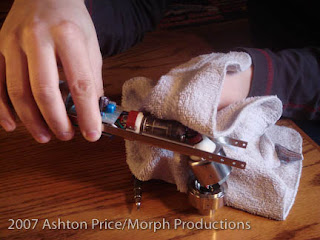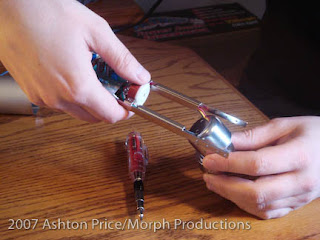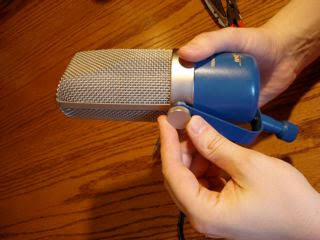LEVELS
First off let's talk about volume levels. It's a common misconception that with digital recordings the volume level should be as loud as possible for everything you're recording. In a perfect world where tracks didn't need further processing and the level coming in was completely predictable this would be fine but we're far from being in a perfect world. Have you looked outside lately?
The reality is that vocalists are dynamic and sometimes unpredictable and who can say how loud that last part of the verse before the chorus will be when you're really getting into it? It's always good to give yourself a bit of headroom while recording in case that happens. Unlike the days of analog recording, digital distortion is not sweet and not desirable. Especially on the featured instrument in the mix... the voice.
Speaking of headroom I need some of that while I'm mixing. See what happens is I add eq, which also adds gain to the signal and if the tracks signal is already at 0dB's then we go back into the digital distortion problem again. It just means I have to go in and turn the volume down of the source track so you've lost some of your advantage of tracking so loud in the first place
For myself I always try to peak (peak as in the highest point the level will get) between -8dB's to -6dB's. This usually gives me enough headroom for what I'm doing and gives me a margin of error while recording someone.
Keep in mind that it's always better to have something quieter than louder. I can deal with quiet pretty easy. Loudness to the point of clipping is very difficult to make sound good.
CREATE A GOOD RECORDING SPACE
If you're recording yourself there's a few easy things you can do to make sure that you get the best sound possible. Right off the bat eliminate noise sources or move away from them. When singing turn off the air conditioner or furnace and then turn it back on again when you're done. If this isn't possible move as far away as possible with the mic pointed away from them. This goes for computer noise as well. If you must record in the same room then stay as far away from it as possible and point it away from it while recording.
When working in an untreated room it's best to remove that sound from your recording as much as possible. You can use one of the many reflection filters that go behind the microphone and/or use blankets hanging on the ceiling or draped over extra mic stands around yourself and the mic effectively making a temporary vocal booth. I did this with my temporary set up upstairs while I was waiting for the new studio to be constructed and it worked out really well. I actually went so far to get acoustic blankets that had grommets on them so I could hang them up with hooks on the ceiling when I needed them.
It's really hard to get a nice present vocal sound when something's been recorded in a small room with no treatment at all. The sound of the room entering into the mic in a big way affects the presence and clarity of the final vocal track's sound.
Here's a link to where I got my acoustic blankets:
http://www.vocalboothtogo.com/acoustic-and-soundproofing-products-vocal-booths/acoustic-(sound)-blankets-for-sound-absorption,-producer’s-choice/sound-blanket-producers-choice-with-grommets.-solid-black/8-25#ja-pathway
Vocal Arrangements
So now that we have a perfect level and sound going into the DAW let's discuss vocal arrangement. For this I'll go over some of the things that work for me:
Rap Verses
There's a bunch of options that work depending on the song and instrumental but at the minimum I'd have one lead and at the most I'd have a lead, a full double, two backup tracks and possibly an adlib track. Either extreme or something in-between will work quite effectively.
Singing Verses
I usually don't double verses but sometimes if the music is dense or the singer isn't strong I find a double will help. If I do harmonies in the verse I can go as simple as one layer or as much as three voices for each layer.
Chorus's
I generally like to triple track the vocals for the chorus. Even if that's all you do this will make the chorus pop a bit more and make it sound more full. I generally do harmonies when I can and if I do I'll do three voices for each harmony. I can have as much as much as 4 different layers sung by 12 different voices if need be.
Adlibs
Under each of these examples there could also be ooh's and aah's or just random adlibs (especially at that last chorus of the song). Sometimes I double them and sometime's I just leave them solo. It depends. Ooh's and aah's are generally tripled though.
The above is an example of arrangements that work for me. You can try other ways just make sure to have a reason behind it. There's nothing more annoying than mixing something with a million adlibs and wondering why they're there.
Keep Your Tracks Organized
So now that you've tracked all your vocals and you're ready to get someone to mix them you have to keep in mind that that person has to make sense of what you've done and there's a lot of work that has to go into each track. Singing tracks will more then likely have to be tuned, all tracks have to be cleaned and organized and placed in the mix. As such keep similar parts on the same track. By that I mean that one harmony for the chorus should be on the same track. Don't randomly put the low harmony under one chorus and then the high harmony under the second chorus on the same track. Another pet peeve of mine is things that should be on the same track being on separate ones. This seems to happen with verses for some reason as if one verse would sit different in the mix than another one. It happens, but if so you can just let me know. Think of each linear track you create as being treated the same in the mix. If it's not going to be treated the same (eq, levels etc) then it should probably be on a separate track.
When naming tracks name them like this so they clump together in like parts:
Vocal Chorus C.wav
Vocal Chorus L.wav
Vocal Chorus R..wav
Vocal Chorus Harm C.wav
Vocal Chorus Harm L.wav
Vocal Chorus Harm R.wav
Verse Lead.wav
Verse Dbl.wav
etc...
See how nice and self explanatory that looks? Remember, if you save me time you save yourself money. Also if my energy is focused on the creative process instead of wondering what I'm suppose to do with tracks labeled Vocal_01 through to Vocal_30 you'll be more happy with the end product!
Here's a link to some more mixing prep tips that I put on my website. Just click on the "How do I get my files ready for mixing" link on this page:
http://www.morphproductions.com/toronto-recording-studio_faq.html#mixtips
Anyway, hope this helps and feel free to contact me if you need help before getting your project started. Always better to ask beforehand rather than sending me the files and finding out you have to redo something.
Catch me on the sites:

























































